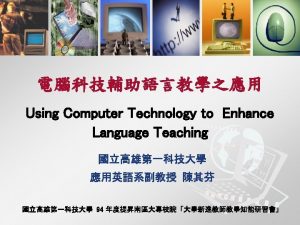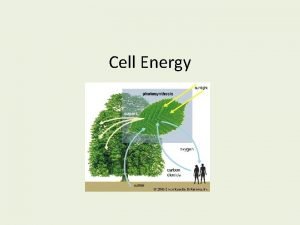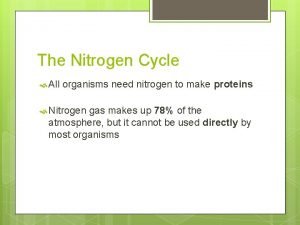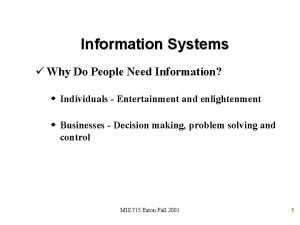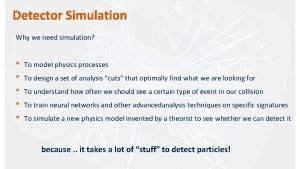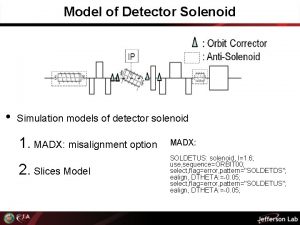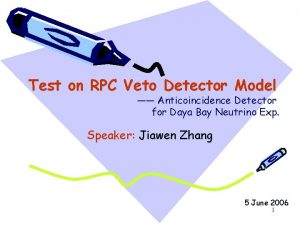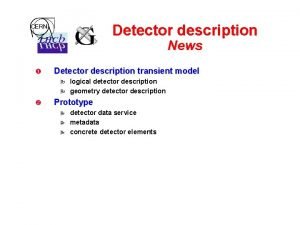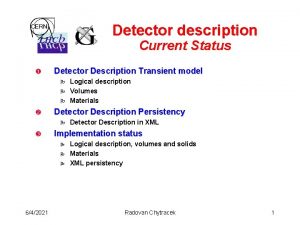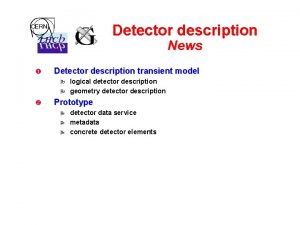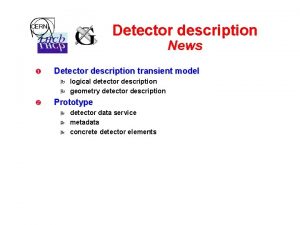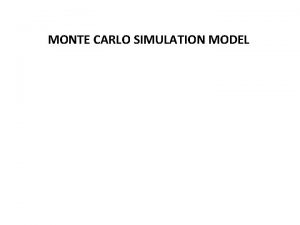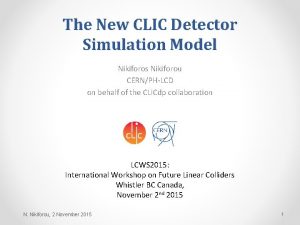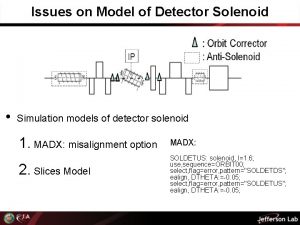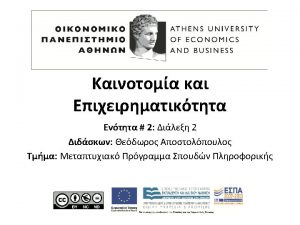Detector Simulation Why we need simulation To model





















- Slides: 21

Detector Simulation Why we need simulation? • • • To model physics processes To design a set of analysis “cuts” that optimally find what we are looking for To understand how often we should see a certain type of event in our collision To train neural networks and other advancedanalysis techniques on specific signatures To simulate a new physics model invented by a theorist to see whether we can detect it because. . it takes a lot of “stuff” to detect particles!

HEP experiment simulation building blocks Event generation Particle interactions inside detector Particle tracking Register interactions in sensitive detectors Detector signal digitization Detector signal reconstruction


Detector simulation: the process The detector simulation takes a set of particles, propagates them through the instrumented volume of the detector, calculating : • • particle energy loss particle trajectories secondary particles response of each of the detector elements to the passage of the particles

Detector Geometry and Materials For the detector simulation an accurate (enough) detector description is needed. The detector definition requires the representation of its geometrical elements, their materials and electronics properties. The geometrical representation of detector elements focuses on the definition of solid models and their spatial position.


Detector response simulation: digitization The physical signal in the sensitive detector element, the detector response, is transformed with the help of electronics into a digital signal, which can be stored on tape or hard drive The simulation of this step is called digitization, and the digitized data, the raw data (”digits”). Typical usages of the digitizer are • • • Simulation of ADC and/or TDC Simulation of readout scheme Generation of raw data Simulation of trigger logics Simulation of pile-up

Geant 4 http: //geant 4. cern. ch/ Geant 4 is a C++ tool kit that tracks particles through matter, breaking the particle motion into small segments, applying appropriate physical processes and probabilities at each segment. It provides a complete set of tools for all domains of radiation transport: • • • Geometry and Tracking Physics processes and models Biasing and Scoring Graphics and User Interfaces Propagation in fields. Geant 4 physics processes describe electromagnetic and nuclear interactions of particles with matter, at energies from e. V to Te. V. A choice of physics models exists for many processes providing options for applications with different accuracy and time requirements.

Simulation of Physics Processes Physics processes describe how particles interact with the material. Seven major categories are provided by Geant 4: • • electromagnetic hadronic decay photolepton-hadron optical parametrization transportation

Simulation of Physics Processes Electromagnetic physics processes Hadronic interactions • Photon processes: Compton scattering, gamma conversion, photo-electric effect, e+e and muon pair production • • • Charged particle Processsed (Electron/posítron, muons, ions …): • ionization and delta ray emission • Bremsstrahlung • positron annihilation • Multiple scattering Optical Photons: • Cerenkov radiation • Scintillation • wavelenght shifting • Absorption • Rayleigh and Mie Scattering. . lepton-hadron interactions photonuclear and electronuclear reactions nucleus-nucleus reactions elastic scattering nuclear cascades fission, evaporation, break-up models low energy neutron interactions radioactive decay

Geant 4 work flow Pre-Initialization Detector construction: Geometry Materials EM Fields Sensitivity Physics List choice: electromagnetic, Hadronic high precison neutrons… + Particle production cuts Run-time N events x Primary vertex generation (from Event Generator): Position Direction Energy Particle type Interaction with detector materials: Production of secondaries, Energy deposits Energy loss Multiple scattering etc Register signals in sensitive detectors: Deposited energy Track momentum Time Position Detector ID Particle type Etc

Geant 4 kernel Geant 4 consists of 17 categories. • Independently developed and maintained by WG(s) responsible to each category. • Interfaces between categories (e. g. top level design) are maintained by the global architecture WG. Geant 4 Kernel • Handles run, event, track, step, hit, trajectory. • Provides frameworks of geometrical representation and physics processes.

CMS simulated event

Geant 4 @LIP Simulation of a Fluorescence Detector of the Pierre Auger Cosmic Ray Observatory

Geant 4 @LIP Simulation of particles interacting in the Martian atmosphere

detailed Martian Energetic Radiation Environment Model atmosphere soil Neutron spectra for a default soil composition (blue line) and corresponding albedo (dashed blue line) and neutron spectrum (red line) and corresponding albedo (dashed red line) for the same soil composition but from which the water contribution was withdrawn.

Detector simulation enables the understanding of complex systems and interactions. It is a fundamental tool in High energy Physics and also in the fields such as radiation interaction studies with Space and Biomedical and radiological applications. It is also a valuable tool for to visualize the complex interactions and is can be used to build virtual experiments!

200 Ge. V gamma ray shower, starting 5 km high.

backup


ALICE as an example Solenoid: magnetic field enabling charged particle momentum measurement ITS and TPC : trackers register the passage ofd charged particles TOF: Time of light detector register the passage of charged particles with high time resolution DCAL and EMCAL: calorimeters Record the energy deposited by charges and neutral particles TRD: Transition radiation detector Fro electron identification HMPID: cherenkov imaging detector For high momentum charged particle ID
 Why why why why
Why why why why Dont ask
Dont ask Why architects need to use their ears
Why architects need to use their ears Shylock
Shylock Why do amebas need to obtain food
Why do amebas need to obtain food Why do we need to breathe
Why do we need to breathe Sources of finance
Sources of finance Why we need computer
Why we need computer Lamillae
Lamillae Why do we need arrays?
Why do we need arrays? Priveleges and immunities clause
Priveleges and immunities clause Why does a cell need energy
Why does a cell need energy Aerobic and anaerobic respiration
Aerobic and anaerobic respiration Why is agility important in tennis
Why is agility important in tennis We need to water
We need to water Why do all organisms need nitrogen
Why do all organisms need nitrogen Why do people need information
Why do people need information Why do we need cracking
Why do we need cracking What are the nine parts of the nail unit
What are the nine parts of the nail unit Nature and aims of business
Nature and aims of business Why do organisms need food
Why do organisms need food Why do we need a government
Why do we need a government







